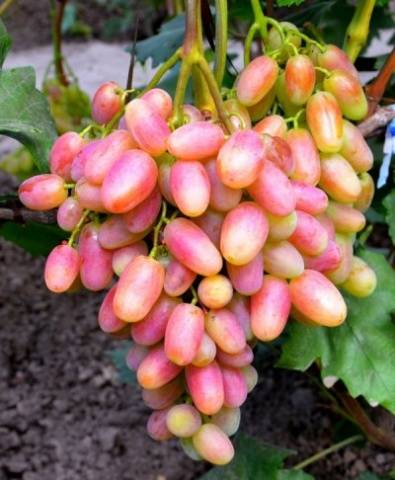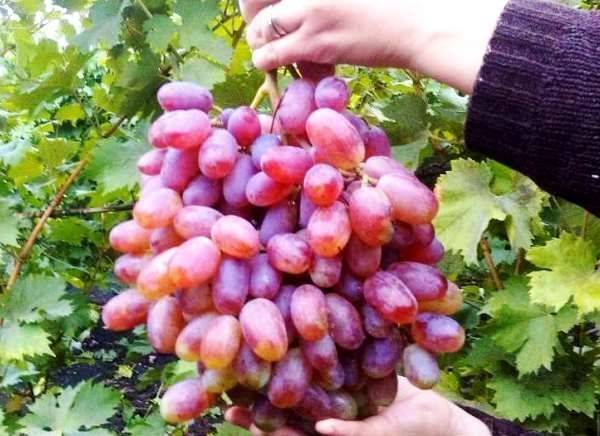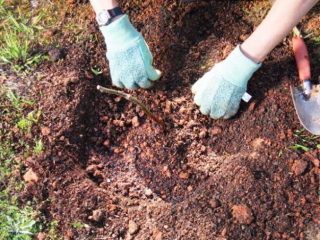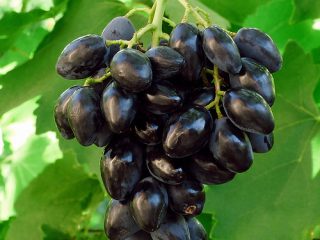Content
Not every grape variety is able to survive the harsh Russian winter and at the same time please the owner with a generous harvest of delicious fruits. The difficulty of growing crops in the northern regions lies in the limited number of warm months. In such conditions, only the very early varieties will have time to ripen. One of them is the Julian grape, characterized by unpretentiousness and high yield.
Main characteristics
Julian is a hybrid resulting from crossing two well-known varieties: “Kesha” and “Rizamat”. The result of the selection was approved by many winegrowers. It would be more correct to start describing the Julian grape variety from the vine. The bushes are characterized by intensive growth. However, the vine manages to ripen quickly along its entire length, which is important for the northern regions. After all, summer here is quite short. The root system is highly branched and similarly characterized by rapid growth. The cuttings of the Julian hybrid have good survival rate, take root quickly, and are also suitable for rootstock for many grape varieties.
Based on the photo, the description of the Julian grape variety can be characterized as a crop that produces large clusters of pink color. Delicious berries are eaten fresh or used to decorate cooked dishes. The Julian variety is considered a table variety.The very early ripening of the bunches occurs in early August. That is, berries need up to 100 days to be edible.
If you look more closely at the photo of Julian grapes, any specialist will determine the similarity of the shape of the bunches with the Rizamat variety. And this is true, because he is one of the parents. Julian’s berries do not fit tightly together. This makes the bunches a little loose. The shape of the berries is smooth, elongated in the shape of a finger. The length of the grape is about 4 cm, and the thickness reaches 2.8 cm. The weight of one berry is 15 g, but there are also larger specimens weighing 20 g. Grape clusters always grow large. With normal care, their weight varies from 0.7 to 1 kg. If you follow all the feeding and care rules, you can get bunches weighing up to 2 kg.
Reviews of gardeners for Julian grapes often begin with a description of the color of the berries. This is due to their unusual beauty. After ripening, the skin acquires a pink color, but at first yellowness predominates, glowing beautifully in the sun. The skin of a fully ripe berry may be partially covered with a lilac tint. The flesh is slightly crispy. The taste is reminiscent of a mixture of nutmeg and strawberries. The seeds are quite soft and there are very few of them inside the grape. The skin is dense but thin. It is practically not felt when eating berries.
Ripe bunches are stored for a long time without losing their presentation.The grapes can be transported, which allows them to be used for commercial purposes. The thick skin does not crack on the berries during storage.
Continuing to consider the description of the Julian grape variety, it is worth noting the frost resistance of the crop. The vine can withstand temperatures down to -23OC. Another important factor is Julian's tolerance to drought. Such characteristics allow the variety to be grown in many regions, even with unfavorable climates. To protect from frost, the vine is lightly covered for the winter. In the southern regions, the temperature does not drop enough to harm the vine, so here the grapes remain attached to the trellis. There is no point in covering the vine.
Julian, like most hybrids, is slightly susceptible to fungal diseases. In a favorable summer, you can avoid spraying grapes with chemicals and still get a good harvest. However, if an epidemic occurs and inclement summers, it is advisable not to take risks. It is better to carry out prevention by spraying with preparations to protect berries and foliage.
Julian grapes can be better characterized by a video that we suggest you watch:
As practice shows, after planting grapes from cuttings, the first harvest with proper care can be obtained in the fourth year.
Pests and bacteria
Looking at photos, reviews, and descriptions of the Julian grape variety, it is worth touching on another important problem - crop pests. Some of them are wasps and birds. If the berries are not cracked from oversaturation with moisture, then insects will not be able to overcome the hard skin. But birds love to eat sweet grapes.When the bunches begin to ripen, it is advisable to cover the Julian plantings with a barrier net.
Bacteria are more difficult to fight. Even an experienced winegrower is not always able to accurately determine what is affecting the crop. Despite the fact that this hybrid has good characteristics, during an epidemic of fungal diseases unpleasant situations occur. Julian is not afraid of bacteria that cause gray mold, oidium, mildew, as well as mites. However, in the hot, humid summer, when the outside temperature ranges from +25OFrom and above, the likelihood of fungal infection increases.
A serious danger to the Julian variety is posed by:
- Many winegrowers define Alternaria blight as oidium. This is a very dangerous disease. The bacterium affects everything: foliage, young shoots, inflorescences and all clusters. The berries become 100% unfit for consumption. At the first manifestations of the disease, Julian's bushes should be sprayed with a 2% solution of Bordeaux mixture. The bacterium can infect even mature grapes lying in the basement. Here you just need to follow the rules for storing grapes.
- In warm regions, Julian grapes are exposed to another dangerous bacterium, which causes spotted anthracnose. The disease manifests itself as darkening of areas of foliage. Over time, they die off completely. The method of struggle is the same - Bordeaux mixture. However, it is necessary to spray Julian grape bushes only after the first shoots have grown to a length of at least 10 cm.
- Downy mildew and mildew are practically not dangerous for the Julian hybrid. However, it's not worth the risk. In hot summers, grape bushes should be treated with preventative medications. If suddenly the disease appears, the vineyard is sprayed with fungicides or a solution of copper sulfate.
Prevention of fungal diseases for the Julian hybrid is mandatory in any case. It is better to prevent an illness than to try to cure it later. Moreover, in some advanced cases, even potent drugs will not help save the harvest.
In the video, the Julian grape variety is presented for better acquaintance:
Planting grape seedlings
You can grow the Julian variety on your site using seedlings. Before planting them, you need to conduct a visual inspection. High-quality planting material has a developed root system. This allows the grape seedling to quickly adapt to open ground and take root. It is best to plant Julian grapes in the spring. This guarantees a higher percentage of seedling survival. The rules for planting Julian are the same, as for all hybrids:
- The place for planting grapes is prepared in the fall. It doesn’t matter whether it’s a hole or a trench, the main thing is to create a nutrient substrate for the root system. It consists of a mixture of humus with fertile soil and the addition of fertilizers. It is important not to forget to equip the planting area for grapes with a drainage layer.
- In the spring, the roots of selected seedlings up to 15 cm are cut off. After this procedure, they are immersed in a stimulating solution for rapid growth. If a grape seedling has weak or damaged shoots, they are cut off with sharp pruning shears.
- A support peg is driven into the center of the hole. It can be a steel rod or a wooden stick. The seedling is lowered into the hole, tied to a peg, then covered with substrate and watered abundantly.
- Under each seedling you need to pour at least 1.5 buckets of water. Over time, the soil in the hole will subside. It will need to be sprinkled.
To ensure that the grape roots receive oxygen, the seedlings are mulched with sawdust.You can add a little humus.
Care during cultivation
Hybrid Julian took all the best qualities from his parents. Due to its resistance to diseases, it is usually enough to do preventive treatment with drugs twice per season. The remaining activities are aimed at watering, fertilizing and bush formation. Caring for grapes involves performing the following actions:
- Before the growing season begins and the grapes are prepared for wintering, the bushes are watered abundantly. At this time, moisture is abundantly absorbed by the roots to charge the vine for the entire period.
- In dry summers, grapes are watered based on the condition of the soil.
- If there is no mulch layer in the hole, the need for organic matter arises. To replenish nutrients, it is recommended to add organic compounds once a year.
- The quality and quantity of the grape harvest can be increased by reducing the overload of the bushes. To do this, remove excess clusters and inflorescences. Typically, 40 to 45 eyes are left for each grape bush. The vines are pruned with 8 or 10 buds.
Hybrid Julian is characterized by one feature. In soil oversaturated with moisture, up to 95% of seedlings survive and develop. And the best quality of the harvest is inherent in the grafted crop.
Reviews
Reviews presented about growing Julian grapes in Siberia say that this hybrid is able to take root even in such harsh conditions.













